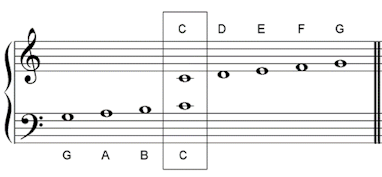The notes on the treble and bass clefs staves all belong to the same “giant” stave which has 11 lines in total. This is called a “grand staff”.

The middle line is normally “invisible”, but I have included it here as faint grey line to make it more obvious. The top half of the grand staff is used for the treble clef (high) notes, and the lower half shows the bass clef (low) notes. Notice how the two clefs meet in the middle, at middle C. We use a ledger line for middle C to make the “invisible” middle line visible.
When music notation was first invented many centuries ago, its purpose was to notate music for singers. The grand staff was designed to fit the “normal” complete range of the human voice, from the very lowest singable note to the very highest. Smaller five-line staves suitable for an individual person’s voice were used, with a “clef” (which comes from the French word for “key”) to identify which part of the grand staff was being used.
In later times, the grand staff was adopted for instruments with keyboards (first the organ, then the harpsichord and similar instruments, and then much later, the piano). The gap where the “invisible” line lives was widened to make the music easier to read, but it still works in the same way:
